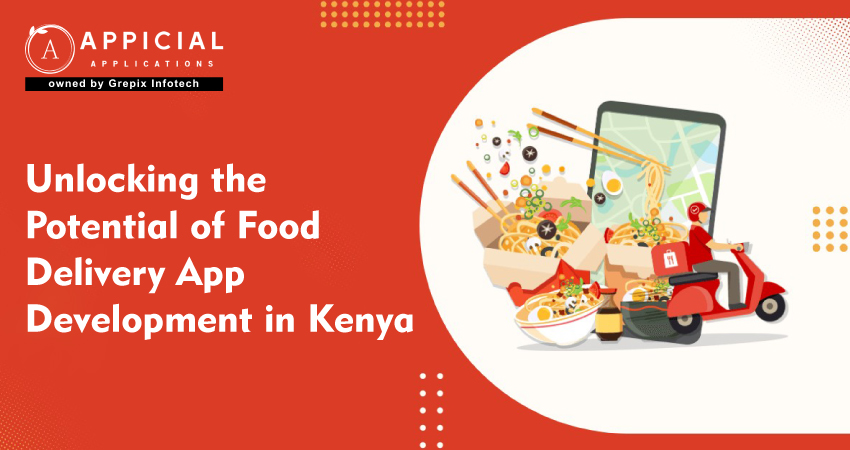
Unlocking the Potential of Food Delivery App Development in Kenya
Let’s be honest.
Nobody likes getting home hungry after a long day, only to start chopping onions.
Or waiting for chapati at a crowded kiosk when you’re late for class.
Or fighting Nairobi traffic when all you want is a plate of pilau.
We’ve all been there.
In these moments, a tap on your phone could change your day. Your food is brought straight to your doorstep, warm and ready to eat.
This is what food ordering apps do.
They save time. They make life easier. They give small restaurants a chance to reach customers across town.
Kenya is alive with people who want convenience, riders looking to earn, and restaurants ready to grow. All that’s missing is a meal delivery tech platform that ties this together.
If you’ve been thinking about creating a food delivery app , the time is now.
People in Kenya are ready.
This guide will walk you through:
- Types of on-demand apps working in Nigeria.
- Features your app needs to work smoothly.
- The real benefits of building one.
- Market trends shaping user expectations.
- How to monetize your app sustainably.
- How Appicial helps you build your own on-demand app without stress.
Kenya’s food delivery scene is buzzing with new opportunities. Riders want a platform that allows them to make money, restaurants are searching for more effective ways to reach customers, and people want the convenience of meal delivery. This is the ideal moment to take action if you've been considering entering this field. In this blog, we examine how making an immediate investment in Kenyan food delivery app development can position you for future success. You will learn the essential features every successful app needs to attract and retain customers. We share the best tech stack to keep your app fast, reliable, and ready to scale. We also highlight the real challenges you may face in Kenya’s market and how to navigate them confidently. You will get a clear look at the costs involved and how long it will take to launch your app, so you can plan your business with confidence. Lastly, we discuss how Appicial Applications can help you create a food delivery mobile app that is genuinely tailored to the Kenyan market, enabling you to provide better customer service and gradually expand your company. This guide will help you move forward with clarity and confidence if you're prepared to establish yourself in Kenya's food delivery market.
Why Invest in Food Delivery App Development in Kenya?
Kenya is changing.
More people are working long hours. Traffic is heavy. Life moves quickly.
When they can place their orders in a matter of minutes, people prefer not to wait an hour in line for lunch. They want to eat while they work, study, or spend time with their loved ones.
And it’s not just customers who need this.
Local restaurants want to serve more people but can’t afford fleets of delivery bikes. Riders want to earn an honest living.
Here’s why now is the moment for food delivery app development in Kenya:
- Everyone has a phone. From Nairobi to Eldoret, smartphones are commonplace.
- People trust mobile payments. Thanks to M-Pesa, paying through an app feels normal.
- Kenyans want convenience. People want time-saving solutions because their lives are busy.
- Young people live on their phones. Ordering online is part of their day.
- Restaurants need better reach. Many want to serve more customers but can’t handle delivery on their own.
If you launch your restaurant app solution now, you won’t just build a business. You’ll be solving a real need for people every day.
Must-Have Features for a Food Delivery App
Your food ordering app should feel easy.
People are hungry. They don’t want to fight with clunky screens or confusing steps.
Here’s what your app needs:
For Customers:
- Simple sign-up with phone or social login.
- Search by dish, price, or location.
- Photos and clear prices for every meal.
- Live tracking so they see where their food is.
- Multiple payment options, including M-Pesa.
- Reorder their favorite meals easily.
- Reviews and ratings to build trust.
For Restaurants:
- A clean dashboard to manage orders.
- Easy menu updates with photos.
- Order alerts so nothing is missed.
- Sales tracking to see what’s working.
For Riders:
- Accept or reject deliveries quickly.
- Maps for clear directions.
- Track daily earnings.
For Admin:
- Manage restaurants, riders, and customers.
- Track orders and payments.
- Run promotions and discounts.
The goal? Make your meal delivery tech feel fast, clear, and dependable.
Technology Stack and Architecture
Your restaurant app solution should be reliable.
You don’t want it crashing at lunchtime when people are hungry.
Here’s what you need under the hood:
- Frontend: Flutter or React Native for Android and iOS apps.
- Backend: Node.js or Django for clean, fast operations.
- Database: MongoDB or PostgreSQL to handle your data.
- Hosting: AWS or Google Cloud for stability.
- Integrations: M-Pesa, Google Maps, and push notifications.
This tech will keep your mobile app for food delivery running smoothly while you grow.
Also Read: Sustainable Practices in Food Delivery App Clones
Challenges and Market Gaps in Kenya
Kenya is bursting with potential for food ordering apps, but it’s not always a smooth ride. Understanding these challenges will help you build a restaurant app solution that actually works for everyday life in Kenya.
- Traffic delays: Anyone who’s been in Nairobi at 5 PM knows how tough traffic can get. Your mobile app for food delivery needs to plan for this reality. Delays can frustrate customers and hurt restaurant trust. Using smart route planning, live rider tracking and clear in-app communication can help manage expectations while ensuring meals arrive as warm as possible.
- Payment hiccups: Mobile payments are the heart of meal delivery tech in Kenya, but sometimes networks drop, or M-Pesa payments fail mid-transaction. This can leave customers worried and restaurants hanging. To build trust, your app should offer multiple payment options and retry logic, so customers can complete payments easily and securely.
- Data concerns: Many customers worry about the cost of data when using food-ordering apps. Heavy apps that drain data can push people away. To win over the Kenyan market, your app needs to be lightweight, fast, and optimized to consume minimal data, ensuring even those with limited bundles can place orders comfortably.
- Local food gaps: Global restaurant app solutions often showcase burgers and pizza while ignoring local favorites like githeri, chapati, pilau, or ugali with Sukuma. This is your chance to stand out. By including Kenyan meals and local restaurants in your mobile app for food delivery, you serve real customer cravings while supporting local businesses.
- Rider shortages: During lunchtime or peak dinner hours, you will need a reliable fleet of riders to keep up with orders. Many meal delivery tech platforms struggle with this, leading to long delays and cancelled orders. Offering flexible earning opportunities, clear delivery zones, and fair rider incentives will help you attract and keep reliable riders who ensure your service remains dependable.
- Restaurant training: Not every restaurant owner in Kenya is tech-savvy. Many are willing to join food ordering apps but may struggle with managing orders, updating menus, or handling delivery instructions through a dashboard. This is where your restaurant app solution can shine by providing a simple, clean backend, clear instructions, and short onboarding videos to help restaurant owners feel confident using your platform.
Every challenge is also your opportunity to stand out with a better food ordering app.
Estimated Development Cost & Timeline
Let’s talk about money and time.
Here’s a clear breakdown for your meal delivery tech:
Cost:
- MVP: $12,000 - $18,000
- Full-feature app: $25,000 - $40,000
- Maintenance: About 15% of build cost yearly
Timeline:
- Research & Planning: 2 weeks
- UI/UX design: 3 weeks
- Development: 10-14 weeks
- Testing & launch: 2-3 weeks
In 4-5 months, your mobile app for food delivery can be live and take orders.
How Appicial Applications Can Help?
Building an app can feel overwhelming.
That’s why you need a partner who knows how to create restaurant app solutions that fit Kenya’s needs.
At Appicial Applications, we:
- Help you launch quickly with ready-made food ordering apps you can customize.
- Integrate M-Pesa for smooth payments.
- Build clean designs people can use easily.
- Set up live tracking for customers and riders.
- Help you scale from one town to many.
- Offer post-launch support so you’re never alone.
We understand Kenya’s market. We are aware of your riders' work habits and what your customers desire. Our goal is to assist you in creating something that genuinely benefits others.
Conclusion
Kenya is ready.
People want convenience. Restaurants want to grow. Riders want to earn. You can bring them together with a mobile app for food delivery that makes life easier.
Your app could help a mother in Nairobi feed her kids after a long day. Help a student in Eldoret get breakfast before exams. Help a small restaurant in Mombasa serve more customers.
This isn’t just about building a business. It’s about helping people.
Applications are available to go with you when you're ready to do this. Let's work together to produce something worthwhile. Let's simplify healthy eating for Kenyans, one delivery at a time.
Ready to build your food delivery app in Kenya? Contact Appicial Applications today and let’s start.
Looking out to start your own venture like Zomato? Try out our MasalaDish Zomato Clone, the easiest way to kick-start your taxi business.Author's Bio

Vinay Jain is the Founder at Grepix Infotech and brings over 12 years of entrepreneurial experience. His focus revolves around software & business development and customer satisfaction.
Back to blog list




